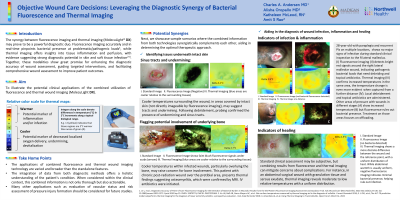Case Series/Study
(CS-009 (RPT-002)) Enhancing Wound Care: The Synergistic Potential of Multi-modal Fluorescence and Thermal Imaging

Methods:
Patients presenting for advanced outpatient wound care were imaged with the multi-modal imaging platform. The handheld device* enabled: [1]real-time mapping of bacterial load/location (fluorescence imaging), [2]real-time thermal information (thermal imaging), [3]co-registered standard images, and [4]digital wound measurement. The impact of multi-modal imaging on diagnosis, treatment planning, and workflow was recorded.
Results: 25 patients were imaged with both modalities at two different institutions (Northwell Health, NY and Madigan Army Medical Center, WA). 32% (8/25) had an isolated positive fluorescence finding, 16% (4/25) had an isolated abnormal thermal finding, and 8% (2/25) had abnormal/positive findings for thermal and bacterial fluorescence. Multi-modal imaging helped inform diagnosis and guide treatment. We present a compilation of the most relevant sample cases to illustrate the uses of both modalities either alone and in combination to obtain enhanced diagnostic results.
Discussion:
Multi-modal imaging findings were found to be both complimentary and synergistic without hindering clinical workflow. Thermal imaging identified tunneling, undermining, and sinus tracts, and alerted areas of increased pressure, enabling proactive intervention. Meanwhile, the fluorescence imaging component enabled targeted hygiene/debridement for proactive bacterial infection management. When used in combination, these modalities supported infection diagnoses including cellulitis. By combining these technologies into a single device, both modalities can be utilized with ease without affecting the workflow and providing a higher level of diagnostic knowledge at the bedside. In addition, the combination of these imaging modalities has great potential to identify pressure and prevent infection and its complications, altogether enabling proactive chronic wound management.

.jpeg)

